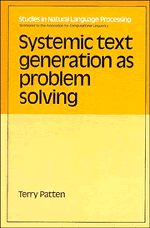Book contents
- Frontmatter
- Contents
- Dedication
- Preface
- 1 Introduction
- 2 Background I: AI problem solving
- 3 Background II: systemic grammar
- 4 The conflation
- 5 The formal model
- 6 The implementation
- 7 Related work in text generation
- 8 Conclusions
- Appendix A OPS5 tutorial
- Appendix B Sample texts
- Appendix C Excerpts from the grammar
- Notes
- Bibliography
- Index
- Frontmatter
- Contents
- Dedication
- Preface
- 1 Introduction
- 2 Background I: AI problem solving
- 3 Background II: systemic grammar
- 4 The conflation
- 5 The formal model
- 6 The implementation
- 7 Related work in text generation
- 8 Conclusions
- Appendix A OPS5 tutorial
- Appendix B Sample texts
- Appendix C Excerpts from the grammar
- Notes
- Bibliography
- Index
Summary
Despite the fact the systemic grammar has a relatively long history, and has been adopted in several computer implementations (Davey, 1978; Mann and Matthiessen, 1983), it has never been rigorously formalized in the way that traditional grammars have. The reason for this appears to be that the formal tools applied to traditional structural (syntagmatic) grammars are not so easily applied to a functional theory. In addition, it seems that the “rigorous rules” used to formalize traditional grammars are viewed by systemic linguists as inherently structural (e.g. Halliday, 1978, pp. 191–2). The formal model of systemic grammar presented here will involve “rigorous rules” but will not compromise the functional perspective. This formalization will allow the definition of such notions as the language generated by a grammar, and the demonstration of results relating to properties of a generation algorithm based on the previous chapter. The central issues discussed include the correctness and efficiency of this algorithm.
Two warnings should be given concerning this formal model. First, the generation algorithm presented (§5.3 and §5.4) is based on the description of systemic grammar presented in Chapter 3 which was in turn based partly on Halliday (1978). As a result of certain assumptions (especially concerning the input to the generation–in this case involving preselection), it may not be compatible with models based on other versions of the theory. Second, this formalization is largely exploratory, in that it is meant to investigate and illustrate the possibility of providing a rigorous formalization of systemic grammar suitable for defining a generation mechanism–it is not meant to be the definitive formalization of systemic grammar.
- Type
- Chapter
- Information
- Systemic Text Generation as Problem Solving , pp. 77 - 103Publisher: Cambridge University PressPrint publication year: 1988



